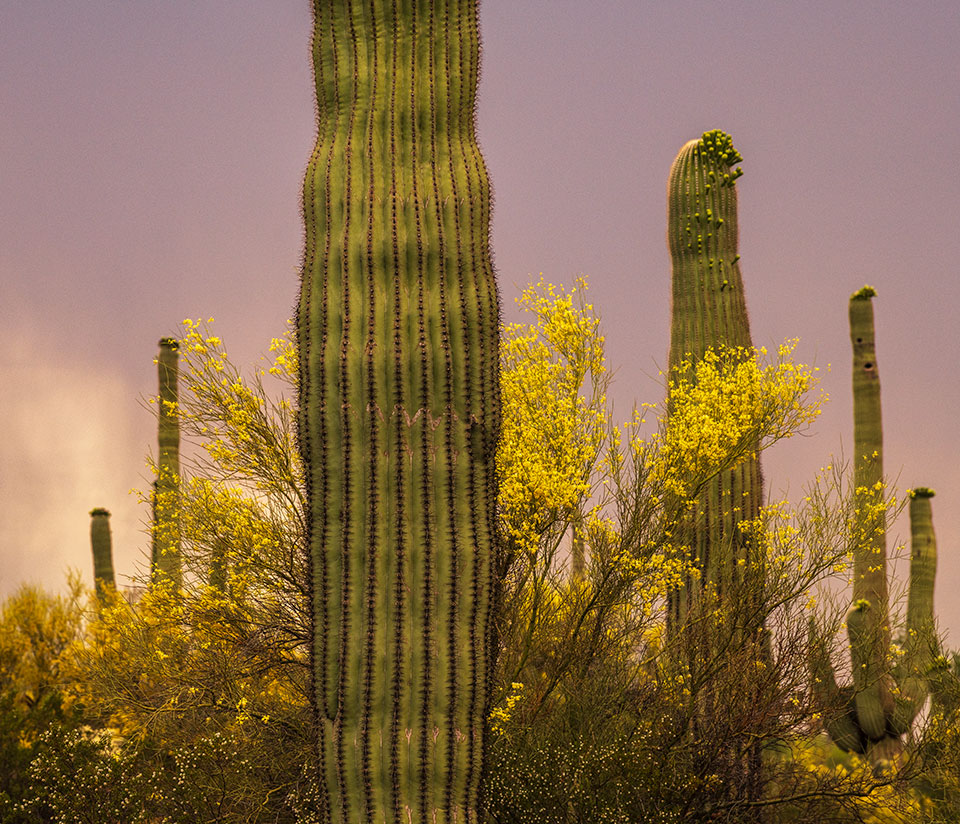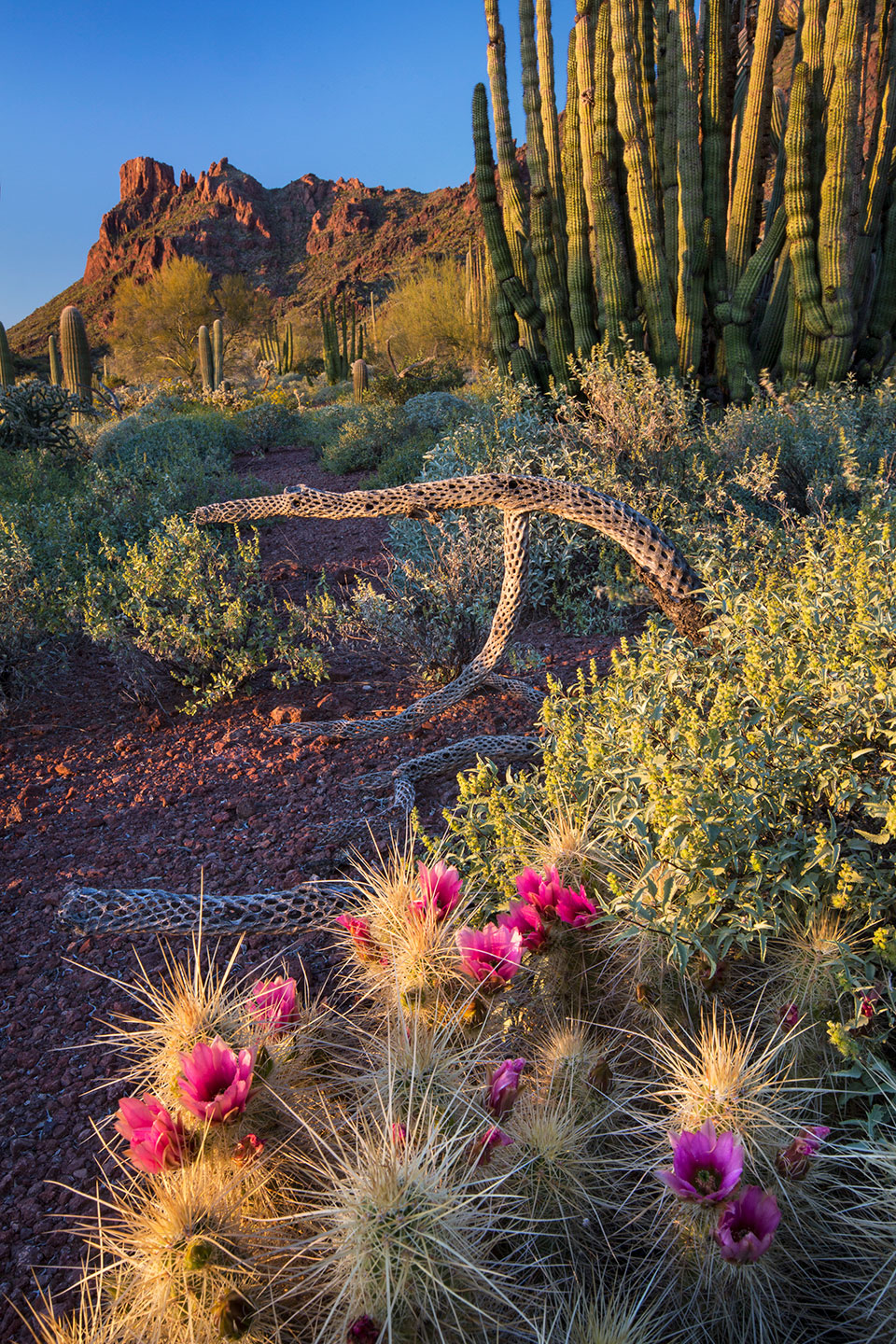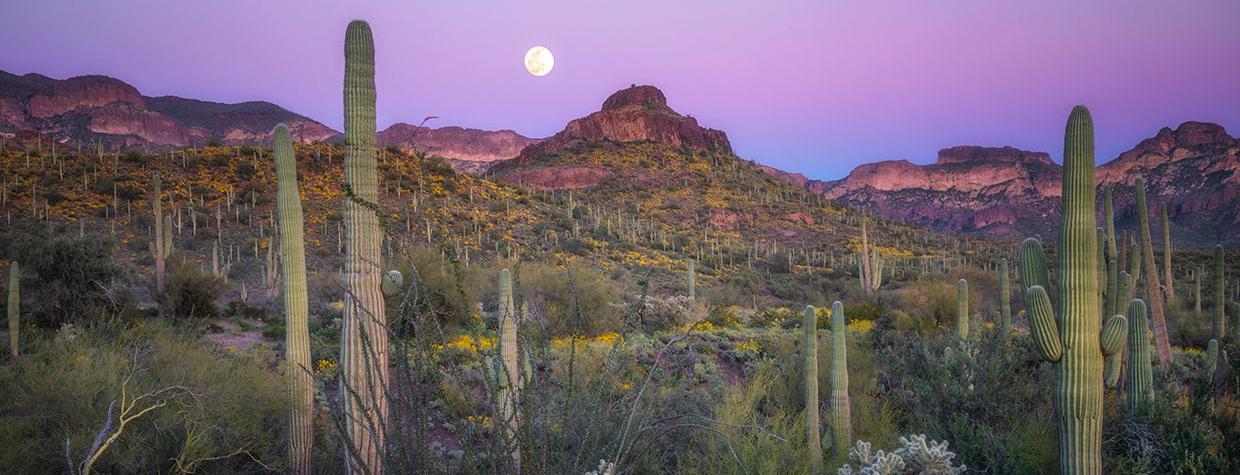Spring is the beginning of time. I know this because my brother and I and our two cousins were all born in the spring. I also know it because spring marks the beginning of the year for the Tohono O’odham people. While gorgeous white blossoms appear on the saguaro tops and at the ends of their arms in late April and May, it is the time of fruiting, in early June, that begins the year. June may be late spring in the Gregorian calendar, but it is spring nonetheless.
Saguaros are hardly the only indicator of spring in the vastness and variety of the Sonoran Desert, but they are the only plant with which I’ve fallen in love. These are cactuses demanding a relationship. They are so vividly connected, I find it hard not to see them as people. Standing in groups of two or three, they are obviously spending their time talking to one another, their language emphasized by arm gestures, by their postures in relation to one another. I’ve not heard their voices, but there is no question they are speaking. I tried to convince my photographer husband to do a book with me about their conversations; he seemed to think I didn’t really understand landscape photography. Only recently have I learned that the Tohono O’odhams, the people who have always lived among them, call them kin.
Although the Sonoran Desert is the country of saguaros — their only country, in fact — the cactuses have become symbolic of the American West everywhere in the world, as easily recognized by the Mongolian yak herder as by the Milanese fashion designer. Presented a picture of a saguaro, either is apt to say, in delight and in English, “Cowboy!”
Saguaros exemplify patience. In no rush to do things, they grow about 1 to 1.5 inches in their first eight years. Protected by “nurse trees” from too much desert sun in their early years, they ultimately reach heights of 40 feet or taller. Outgrowing the need for the nurse tree’s shade, they rob the tree of water, causing its demise. About 35 years old before they begin producing flowers, they require 50 to 70 years, or sometimes a century, for arms to appear. At age 125, they’re considered adults. Fully hydrated, saguaros weigh between 3,200 and 4,800 pounds, about half the weight of a female elephant. (This observation may not be a particularly relevant fact about the Sonoran Desert.) Their usual life span is 150 to 175 years, although biologists believe some plants might live more than 200 years. In any case, they outlive us. So, when these guys stand around talking in the desert, they have the wisdom of years.

Deserts, I think, teach time. They give the Earth space to breathe, an opening of the Earth to sky, a pause between forests and oceans, an experiment in ways to live. In the biodiverse Sonoran Desert, the wettest desert in North America, all the usual spring events are extant. Trees bud. Wildflowers bloom. Wildlife is born. There is a change in how the sun acts, how the planet turns, how the Earth dances. This is true everywhere: desert or deepest forest, Arctic Circle or equator. But only in the Sonoran Desert do saguaros, those most human of plants, grow.
The Sonoran covers 120,000 square miles of Arizona, California and Mexico. Most of Arizona’s portion is in the southern third of the state, and it includes Phoenix and Tucson. The region in South-Central Arizona and Northern Sonora, Mexico — the highest and coldest section — can experience hard winter frosts.
The Sonoran Desert includes nearly all of Earth’s biomes, from palm trees in the Kofa Mountains (those are California fan palms, thought to be remnants of some long-ago ice age) to ponderosa pines, Douglas-firs and sometimes snow on 9,131-foot Mount Lemmon, which boasts the southernmost ski area in the continental United States. The ironwood, a common nurse tree for saguaros (along with paloverdes and mesquites), is a singular tree. With geographical limits essentially matching the Sonoran Desert’s boundaries, it seems made to be a companion to saguaros. It also is quite beautiful in its lavender or purple blooms, which it produces on a schedule all its own. Possessing one of the world’s heaviest woods, it is resistant to rotting, making it essentially non-biodegradable.
Spring possesses urgency: in the way mountain water rushes down deep canyons, a surging, lithic run into this new season; in the sounds of birdsong, of nesting birds or resting birds headed north to nest. More than 350 bird species live in or pass through the Sonoran Desert. For birders, spring here might be a near-equivalent of nirvana.
In March and April of a good spring, poppies cover hillsides and the spaces between the hills, and globemallows, gilias, hyacinths, marigolds, lupines, owl’s clover, desert lavender and brittlebushes paint a desert canvas to fill any plein air artist with joy. In such a miracle of spring, photographers are almost as ubiquitous as poppies. “Earth laughs in flowers,” Ralph Waldo Emerson wrote. He wasn’t writing about the desert, but the context of any writer’s words is irrelevant in the face of their truth. Few places on Earth are so giddily joyous as a desert landscape in its time of flowering.
If the monsoon rains come, if a wet winter follows, if everything necessary for the desert’s moisture happens, this kind of display will occur, although, even in the best of times, such a spectacle might take place only once a decade. Absent that, good wildflower displays can still happen in localized areas.
Deserts develop in arid climates. Desert plants, like desert animals, have evolved to survive in this aridity, in normal times of drought. Drought itself is part of how the Earth works. A warming climate is a different story, and the Sonoran Desert is as subject to the effects of climate change as the rest of the natural world. According to Defenders of Wildlife, precipitation here has dropped by 25 to 40 percent over the past 50 years. The average temperature, having risen by about 1.5 degrees since the mid-20th century, is poised to rise more. Rising temperatures play havoc with spring. Not to mention the rest of life.

My first experience of the Sonoran Desert occurred one spring, years ago, at Organ Pipe Cactus National Monument. It was one of the good years for flowers, with poppies spreading across the desert floor to Mount Ajo. As a Northerner, this was my introduction to cactuses — the first organ pipes and saguaros and ocotillos I’d ever seen, and the first teddy bear chollas. I found their name, Cylindropuntia bigelovii, perfect. “Big love,” it seemed to mean. How could one not have big love for so cuddly-looking a plant? I did change my mind after discovering (thank heavens, not personally) that this teddy bear’s spines are barbed. Getting too near the plant is not unlike the experience of having one’s dog roll on a dead porcupine.
Nearly 300 bird species have been recorded at Organ Pipe, but the monument is home to just one fish species: the endangered Quitobaquito pupfish, which in the U.S. lives in the wild only at Quitobaquito Springs, a small reservoir along the border. Also found there are the Sonoyta mud turtle, the pepper-grain-size Quitobaquito spring snail and the desert caper plant. A real oasis, Quitobaquito was used by the O’odham people for thousands of years, then by settlers to the region, but signs of its past use were removed once Organ Pipe was designated a national monument. When I visited, the beauty of the pond, the colors and movement, and a kind of time radically different from that of the desert surrounding it seemed a geography of magic.
Never mind that trucks roared by on Mexico’s Highway 2, a few hundred feet south of Quitobaquito. At the time, they seemed irrelevant, other than as a way to see how close I was to Mexico. For me, the border meant an artificial split in land rightfully belonging to the Tohono O’odhams. El Pinacate y Gran Desierto de Altar, like Organ Pipe a UNESCO international biosphere reserve, lies on the Mexican side of the road, the two wild areas constituting a landscape that is really one piece. During my visit, the border wall did not yet exist.
In writing this, I’m aware of how much of the Sonoran Desert spring I’ve skipped: the Sonoran pronghorn, an endangered subspecies of the fastest land animal in North America (its speed possibly acquired to outrun the long-extinct American cheetah); the desert tortoise, which lives for 50 years or longer, much of it underground, and for which spring is a prime foraging season; and the marvelous little elf owls, perching in saguaro cavities. All are vital to this ecosystem at this time of year. But there are four other seasons in the Sonoran Desert, according to many scientists: “foresummer,” summer, fall and winter. Maybe I can write about animals in autumn.

